Chapter: Mechanical and Electrical : Power Plant Engineering : Steam Power Plants
Fuel Handling System
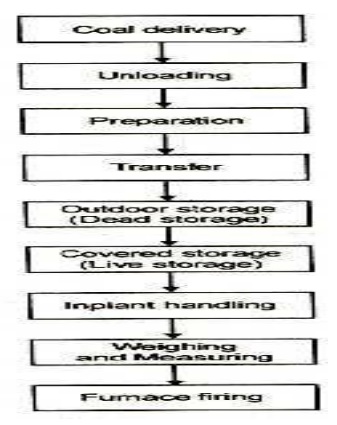
Coal needs to be stored at various stages of the preparation process, and conveyed around the CPP facilities. Coal handling is part of the larger field of bulk
Material handling, and is a complex and vital part of the CPP.
FUEL HANDLING SYSTEM
Coal delivery equipment is one of the major components of plant cost. The various steps involved in coal handling are as follows:
1. Coal delivery.
2. Unloading
3. Preparation
4. Transfer
5. Outdoor storage
6. Covered storage
7. Implant handling
8. Weighing and measuring
9. Feeding the coal into furnace

i) Coal delivery
The coal from supply points is delivered by ships or boats to power stations situated near to sea or river whereas coal is supplied by rail or trucks to the power stations which are situated away from sea or river. The transportation of coal by trucks is used if the railway facilities are not available.
ii) Unloading
The type of equipment to be used for unloading the coal received at the power station depends on how coal is received at the power station. If coal delivered by trucks, there is no need of unloading device as the trucks may dump the coal to the outdoor storage. Coal is easily handled if the lift trucks with scoop are used. In case the coal is brought by railways wagons, ships or boats, the unloading may be done by car shakes, rotary car dumpers, cranes, grab buckets and coal accelerators. Rotary car dumpers although costly are quite efficient for unloading closed wagons.
(iii) Preparation
When the coal delivered is in the form of big lumps and it is not of proper size, the preparation (sizing) of coal can be achieved by crushers, breakers, sizers, driers and magnetic separators.
iv)Transfer
After preparation coal is transferred to the dead storage by means of the following systems.
1. Belt conveyors
2. Screw conveyors
3. Bucket elevators
4. Grab bucket elevators
5. Skip hoists
6. Flight conveyor
Belt Conveyor
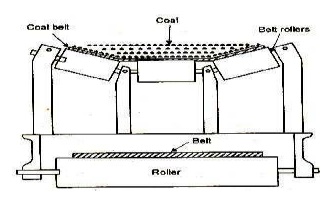
Figure shows a belt conveyor. It consists of an endless belt moving over a pair of end drums (rollers). At some distance a supporting roller is provided at the centre. The belt is made up of rubber or canvas. Belt conveyor is suitable for the transfer of coal over long distances. It is used in medium and large power plants. The initial cost of system is not high and power consumption is also low. The inclination at which coal can be successfully elevated by belt conveyor is about 20 .Average speed preferred than other types.
2. Screw Conveyor
It consists of an endless helicoid screw fitted to a shaft (figure). The screw while rotating in a trough transfers the coal from feeding end to the discharge end.
This system is suitable, where coal is to be transferred over shorter distance and space limitations exist.The initial cost of the consumption is high and there is considerable wear o screw. Rotation of screw varies between 75-125 r.p.m
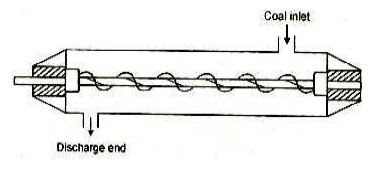
3. Bucket elevator
It consists of buckets fixed to a chain (figure). The chain moves over two wheels. The coal is carried by the bucket from bottom and discharged at the top.
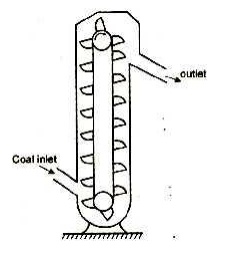
4. Grab bucket elevator
It lifts and transfers coal on a single rail or track from one point to the other. The coal lifted by grab buckets is transferred to overhead bunker or storage. This system requires less power for operation and requires minimum maintenance.
The grab bucket conveyor can be used with crane or tower as shown in figure . Although the initial cost of this system is high but operating cost is less.
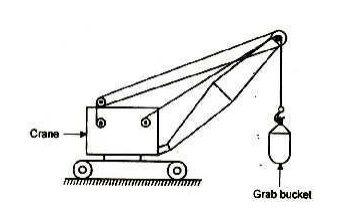
Storage of Coal
It is desirable that sufficient quantity of coal should be stored.Storage of coal gives protection against the interruption of coal supplies when there is delay in transportation of coal or due to strike in coal mines. Also when the prices are low, the coal can be purchased and stored for future use.
The amount of coal to be stored depends on the availability of space for storage, transportation facilities, the amount of coal that will whether away and nearness to coal mines of the power station. Usually coal required for one month operation of power plant is stored in case of power stations is situated at longer distance from the collieries whereas coal need for about 15 days is stored in case of power station situated near to collieries. Storage of coal for longer periods is not advantageous because it blocks the capital and results in deterioration of the quality of coal.
Related Topics